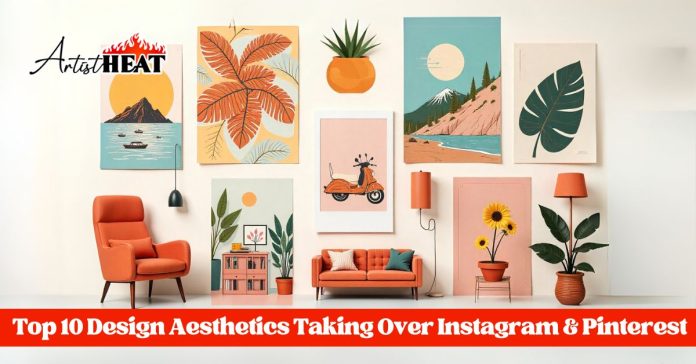Let’s be honest – if you’ve been browsing through your feeds lately and you’re feeling like you’re stuck in some kind of an aesthetic singularity, you’re not alone. The design aesthetics taking over Instagram & Pinterest in 2025 are wilder, bolder, and honestly more chaotic than anything we’ve seen before. The times were gone when we all could agree on being minimalistic or cottagecore. Now? It is as though all the creative individuals in the world just chose to hurl whatever crazy ideas they have at the wall to see what becomes what.
Being a person who spends far too much time examining what causes people to press the double-tap buttons, I have been following these new trends which are literally redefining our thinking about visual content. Some of these design aesthetics taking over Instagram & Pinterest are gorgeous, some are questionable, and others make me wonder if we’ve collectively lost our minds. However, the thing is that they all will receive serious engagement, and this is what counts in 2025.
The New Era of Digital Maximalism
Cyber-Baroque Overload
Do you recall the time when all people were crazy about empty spaces and clean lines? Yupp, that ship sailed into the black hole. The only thing that happens when historical level of opulence combines with digital anarchy is the cyber-baroque movement, and frankly it is quite brilliant in its audacity.
Consider gold frames and holographic NFT art or marble sculptures wearing virtual reality helmets. Artists such as Filip Custic and digital designers such as Six N. Five are driving this style to the furthest point possible. The design aesthetics taking over Instagram & Pinterest in this category are getting millions of views because they’re so extra that you can’t look away.
This is a tendency being successful because it’s exactly the opposite of the boring minimalism we have been pounded to death with for decades. People are looking for something that’s going to give them a mental workout and cyber-baroque does that by the truckload.
Hyperstition Futurism
Here is the pretentious sounding part, so I suggest you hang on. Alternatively, hyperstition futurism is conceptualizing images of futures that do not exist and yet, they feel so real to an extent that they determine how the future is going to feel. It is not that pretty picture but visual prophesy.
We are getting it in architecture drawing of impossible structures to fashion photos that look like they were taken in 2045. The aesthetic is a mixture of brutalist architecture and iridescent materials and unattainable lighting. Artists such as Andr es Reisinger and digital studios such as FIELD.IO are killing this vibe, on the spot.
The Rebellion Against Perfection
Glitchcore Authenticity
That is where things become interesting. As Instagram has had years to teach us to post only well-guided photographs, glitchcore is the two-finger salute to it all. This beauty is an exaltation of digital artifacts, compression effects and intentionally fractured images.
The design aesthetics taking over Instagram & Pinterest in this space include deliberately pixelated portraits, databending experiments, and images that look like your computer had a minor stroke while rendering them. It is punk rock in the digital era, and Gen Z is literally addicted to it, since it is real in the age of perfect images.
Artists such as Rosa Menkman and JODI have been early adopters in this area, but now is seeing the mainstreaming of this in social media with such apps as Datamosh and Glitch Lab being exploited and used by manipulators to create condensed chaos.
Anti-Instagram Instagram
This may seem counter-intuitive but bear with me. Anti-Instagram Instagram is the style of purposefully advancing the defective photographs that turn out to somehow be utterly amazing. Consider out of focus concert shots, non-flattering selfies with severe lighting and screen shots of screen shots.
The brilliance of this trend is the fact that it can be accessed by all. You do not have to invest in costly devices and Photoshop skills. All you have to do is have the confidence to post something that will appear to be an accident, yet is well thought out to seem spontaneous.
The Rise of Sensory Overload Design
Chromesthetic Maximalism
If you’ve been wondering why your Insta feed is currently covered in festive aes and technicolor lava, thank chromesthetic maximalism. This design aesthetic taking over Instagram & Pinterest is all about using color combinations that shouldn’t work but somehow do.
We mean neon pink with forest green, electric blue, and burnt orange, color gradient-type coloring that gets your eyes to tearing the best way possible. This is so that you can visualize what you can almost taste or hear, that is why it is being called chromesthetic it is meant to evoke senses similar to that of synesthesia.
Digital artists such as Zach Lieberman and studios such as Universal Everything are experts in this method, developing a visual language that seems to be spluttering out of the screen.
Tactile Digital Textures
What is most interesting about the trend is that it is attempting to answer the real issue of digital media which is that you can not touch it. There is tactile digital texture rendering, which is mind boggling detailed so it makes you want to reach through your PC and touch the surface.
Here think hyper-realistic velvet so soft you would want to touch your phone over, or metal surfaces made so precise you can breathe cold. The design aesthetics taking over Instagram & Pinterest in this category are getting crazy engagement because they tap into our basic human need for physical connection in an increasingly digital world.
John Gasparro (Backburner), Peter Tarka and Six N. Five softly smashing it out in the 3D department, that’s right more real than real.
The Nostalgic Future Movement
Y3K Retro-Futurism
Can you imagine the year 2000 was so farfetched? Y3K retro-futurism takes the latter energy and puts it still further into the future. It is what people of 1999 imagined 3025 to be with chrome on everything and holograph interfaces.
It is a retro-future aesthetic that integrates this nostalgia of the early 2000s technology with future-gazing speculation on what is next. Imagine transparent electronics, impossibly reflective surfaces, and just ask yourself, is this the user interface to a sci-fi film set in 2003 or does it crash?
This is being driven by artists such as Alexis Christodoulou and digital designers, such as Tomorrow Bureau, to make images, that look nostalgic at the same time and unsurreally future.
Cottagecore Cyberpunk
This may not be the strangest pairing in this list, but it is even more omnipresent. Cottagecore cyberpunk is a mix of the pandemic-induced love affair with cozy, rural looks and the dystopian digital wash of cyberpunk.
Imagine moss covered computer servers in disused data centres or fiber optic cable turned into fairy lights. It is the aesthetics of the beauty of technological ruination and it also responds to our own fears of the future though at the same time we also have an optimism to communicate with this nature.
The Influence Economy Backlash
Poverty Core
Do not be mad at me just because of the name before I tell you. Poverty core is not laughing at the real poverty, it is a backlash of the Lawrence Lessig pointless display of affluence in the social media. This design aesthetic taking over Instagram & Pinterest celebrates finding beauty in cheap, accessible, and DIY solutions.
It is thrift-store bargains, ramen noodle aesthetics, and apartment living that does not attempt to conceal its shortcomings all photographed and designed in a deliberate manner by creators. It is real in a way which feels like a revolution after years of people all lying that their lives are flawless.
The visual code encompasses cold harsh fluorescent lamps, pricing tags on display, and the style that is enthusiastic about low prices and not ashamed of them. It is punk rock economics and social media uprising.
Institutional Chic
It is a strange albeit intriguing one. Institutional chic is the appropriation of the visual vocabulary of schools and hospitals and government buildings and some how turning it into an aspiration. Consider beige computer terminals, fluorescent lights, and industrial carpets as style of no stripe, but of choice.
The design aesthetics taking over Instagram & Pinterest in this category play with our complicated relationships to authority and conformity. The institutional design feels somehow familiar in a way that it is selected, not forced.
Such artists as John Divola and photographers such as Todd Hido have contributed to this movement, but they did not expect their work to give birth to Instagram room tours.
Looking Forward to What’s Next
The thing about design aesthetics taking over Instagram & Pinterest is that they’re constantly evolving. What is hot now, will be old news tomorrow and something totally out of character will right in. However, 2025 has taught us that human beings are desperate to see something that resembles the truth, even though said truth is not real at all.
These are trends of the mood we all are in, we are all sick of faking to be okay, we are all captured by the possibilities of technology, we are all homesick in the past and rebel against the systems we don not need anymore. The design aesthetics taking over Instagram & Pinterest aren’t just pretty pictures; they’re visual manifestations of how we’re processing an increasingly complex world.
Wether you adore these trends or believe they are sheer nonsense, there is one definite thing about them, they are not leaving the scenario any time soon. Therefore, hold on to your belts as what has 2025 turned out visually in terms of craziness 2026 is going to be a whole different crazy infinity.

